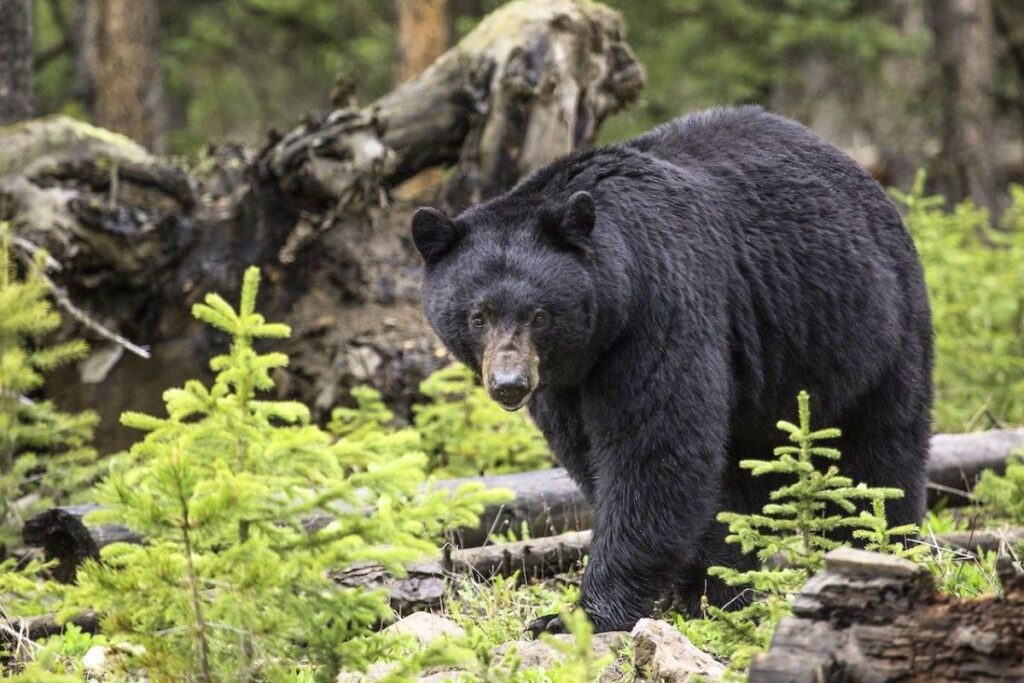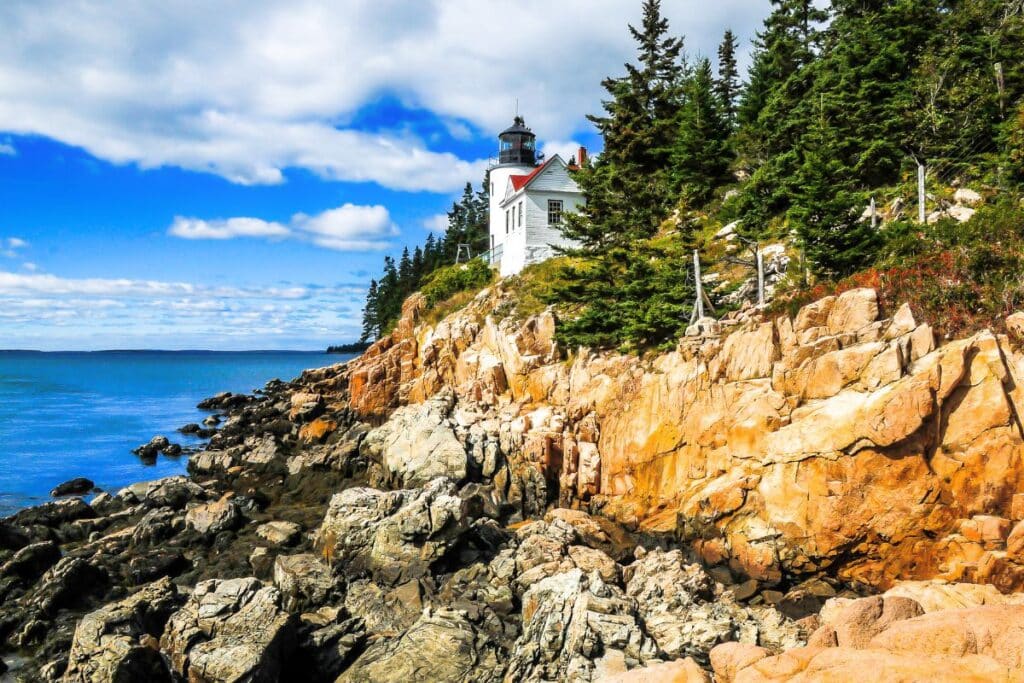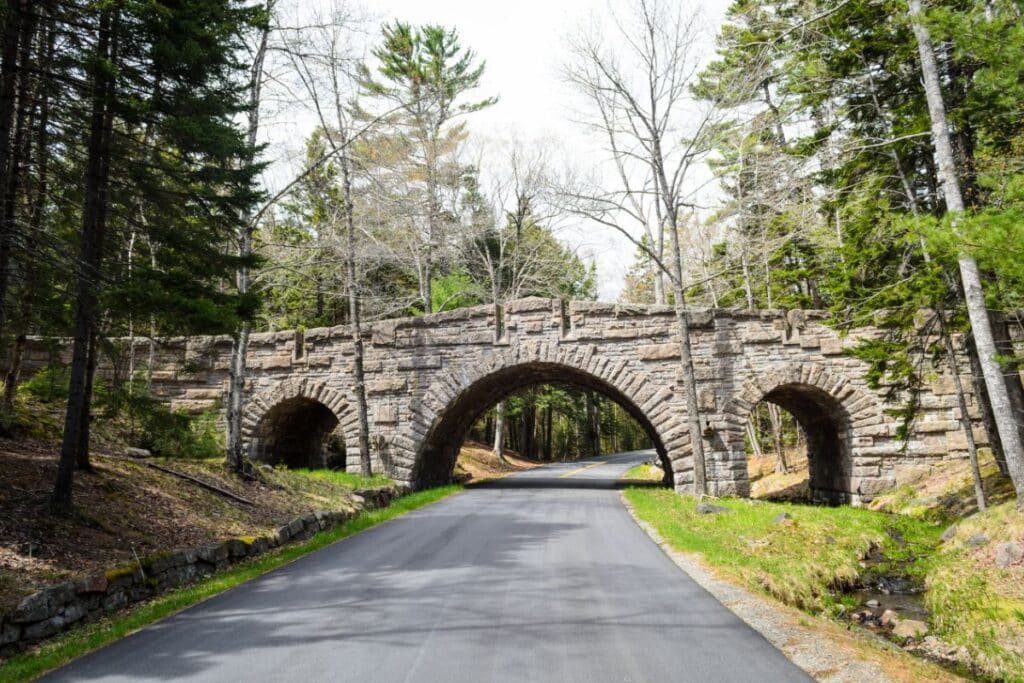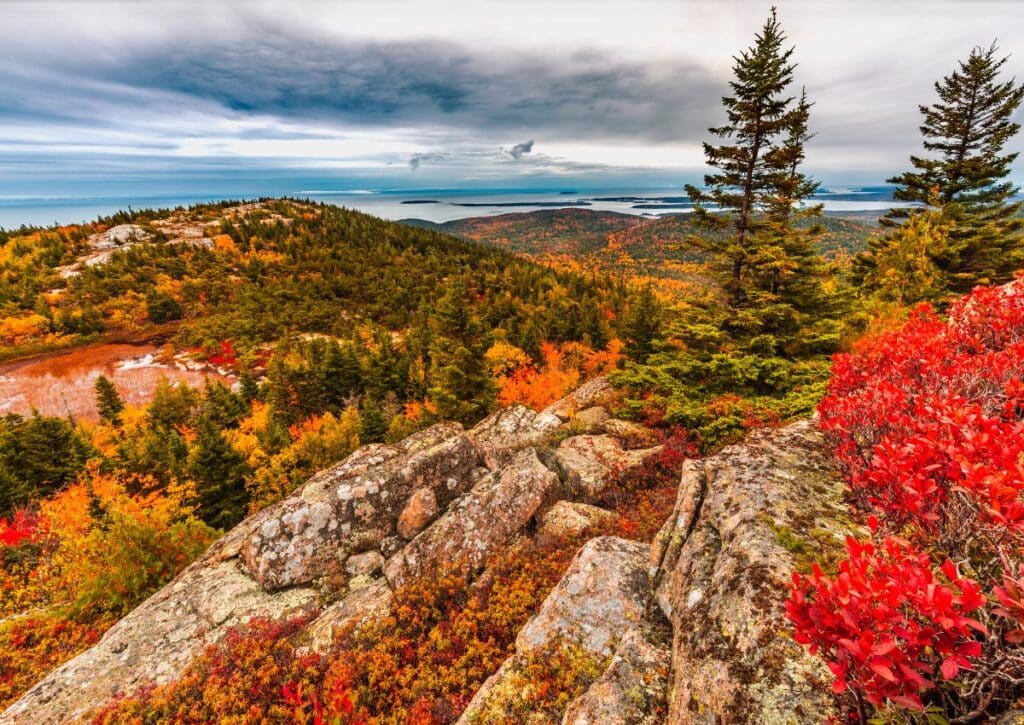Discover 12 incredible animals in Acadia National Park encountered during our hikes. From red foxes to black bears, experience wildlife like never before.
Ever had a wild raccoon play peek-a-boo with you from behind a tree? Or felt the silent, piercing gaze of an owl from the shadows? That’s Acadia for you. A place where nature isn’t just scenery – it’s an experience.
In our travels, we’ve found that the real pulse of a place isn’t always in its landmarks, but in its living, breathing residents.
The Acadia National Park wildlife truly brought this sentiment to life. From stealthy foxes to graceful deer, every encounter added a new chapter to our adventure.
We set up our camp amidst the dense foliage and starry nights of Acadia National Park, and guess what? The true magic wasn’t just in the campfires or the hikes.
It was in those unexpected, breathtaking encounters with animals we’d only seen in documentaries.
Curious about the wild side of Acadia from a hiker’s lens? Dive in. We’re pulling back the curtain on our most unforgettable wildlife moments.
12 Animals in Acadia National Park We Have Seen Over the Years
While the park boasts of numerous species, during our time camping and exploring Acadia, we were fortunate enough to come face-to-face with 12 remarkable animals that left a lasting impression. Here’s a recount of these fascinating encounters:
Red Fox
The unmistakable reddish-brown coat of the red fox often caught our eye during our escapades in Acadia. These sly creatures seemed to have a fondness for the early morning and dusk hours, especially near the fringes of the Blackwoods Campground.
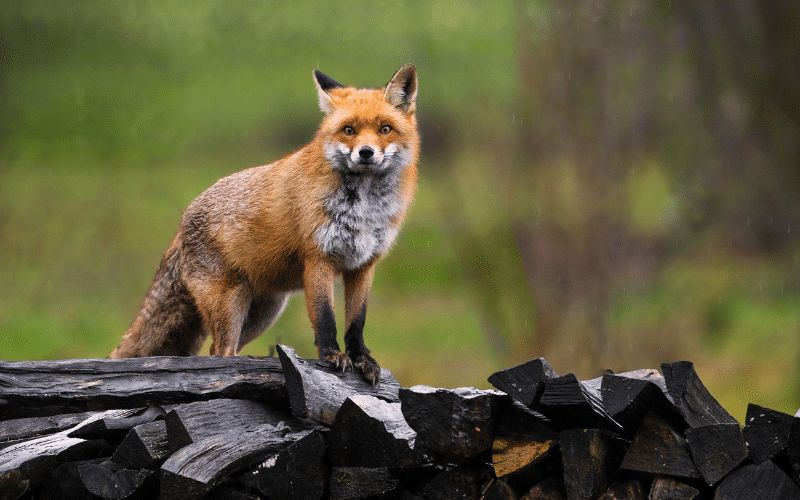
If you’re setting out with hopes of spotting one, the Cadillac South Ridge Trail might be your best bet. It’s the forested sections here that seem to provide just the right cover for them. And remember, a silent tread might just reward you with a rare sighting.
But Blackwoods isn’t their only haunt. Some fellow campers shared their tales of fox encounters at the Seawall Campground.
It appears that these foxes have a preference for the quieter months when human hustle is at its minimum.
A fascinating tidbit about these creatures? Their adaptability is legendary. Forests, grasslands, mountains, and even bustling urban environments – they’ve claimed it all. Their diverse palate, feasting on everything from rabbits to fruits, makes them master survivors.
And here’s a unique fox trait: they tap into Earth’s magnetic field during their hunts. In the heart of winter, they’ll leap towards magnetic north, zeroing in on prey concealed beneath the blanket of snow. Intriguing, isn’t it?
Barred Owl
With its soulful eyes and striking appearance, the barred owl quickly became one of our most memorable encounters in Acadia. Most of our sightings were nestled high among the trees in quieter areas, especially when we were close to freshwater sources.
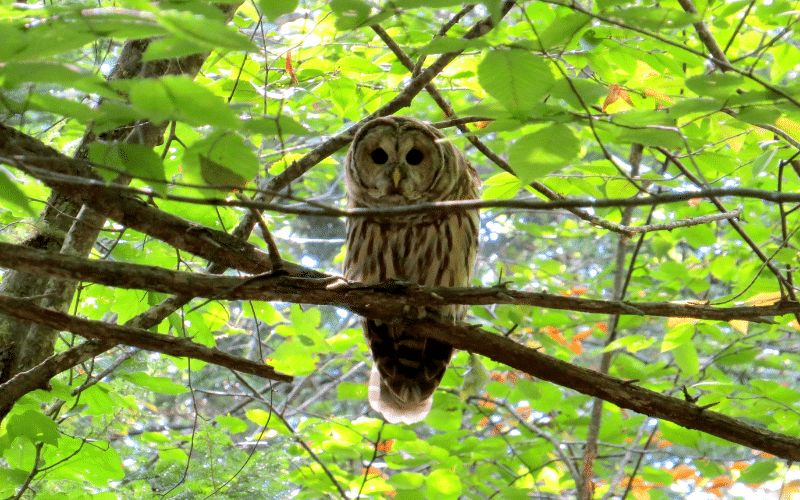
If you’re an avid bird watcher or just someone hoping for an owl experience, you might want to try the Jordan Pond Path.
The surrounding dense woods, with a blend of both coniferous and deciduous trees, seem to resonate well with the preferences of this majestic bird.
While we had most of our encounters near Blackwoods Campground, we’ve also heard reports from other campers spotting them around the Seawall Campground.
It seems the twilight hours, just as the world transitions from day to night, are their preferred time to be active.
Unlike many other owls, the barred owl has a deep, rich hooting call that sounds like they’re saying “Who cooks for you? Who cooks for you-all?” If you hear this echoing through the forests of Acadia, you’ll know there’s a barred owl nearby, perhaps watching you with its piercing gaze.
They’re known to be quite aggressive during nesting season, often not hesitating to swoop down near humans if they feel their nest is threatened. Always remember to admire from a distance!
White Tailed Deer
The graceful silhouette of the white-tailed deer, bounding effortlessly through Acadia’s varied terrains, is a sight to cherish.
These gentle herbivores, with their expressive eyes and characteristic white underside on their tails, often graced us with their presence during our early morning hikes.
The Ship Harbor Trail, with its mix of forested stretches and open spaces, proved to be a hotspot for deer sightings.
One of the most enchanting places to catch a glimpse of these deer was near the edges of the freshwater lakes.
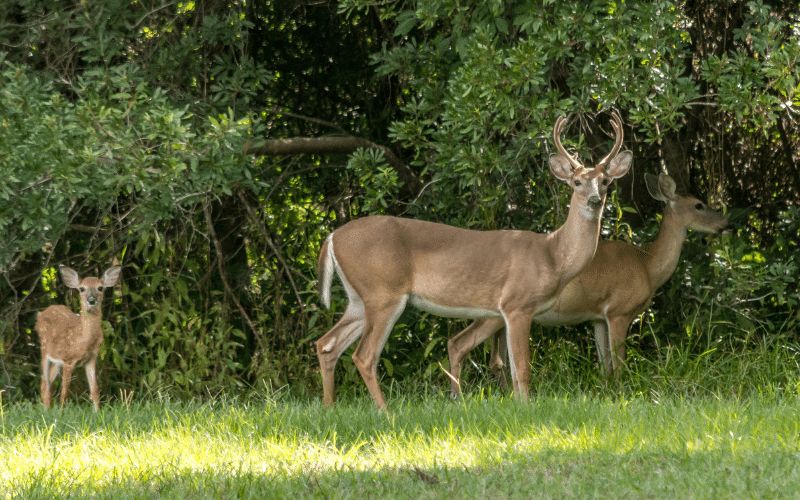
On a particularly lucky day, while on the Wonderland Trail, we were treated to the sight of a doe and her fawn, cautiously approaching the water’s edge for a drink.
Within the campgrounds, the Schoodic Woods Campground held the most tales of deer sightings. Many a camper recounted the charm of spotting them in the gentle embrace of twilight, the setting sun casting long, meandering shadows behind them.
Did you know white-tailed deer can jump heights of up to 10 feet and lengths of up to 30 feet in a single bound?
This agility, combined with their keen sense of smell and alertness, makes them one of Acadia’s most graceful yet resilient inhabitants.
Their nocturnal habits, primarily being active during dawn and dusk, give them the name “crepuscular” animals. If you’re in Acadia, be patient and tread softly, and you just might be rewarded with a magical deer moment.
Snowshoe Hare
Snowshoe hares are found in Acadia National Park and surrounding areas, including the Schoodic Peninsula. These small mammals are not to be confused with rabbits, which are also present in the park.
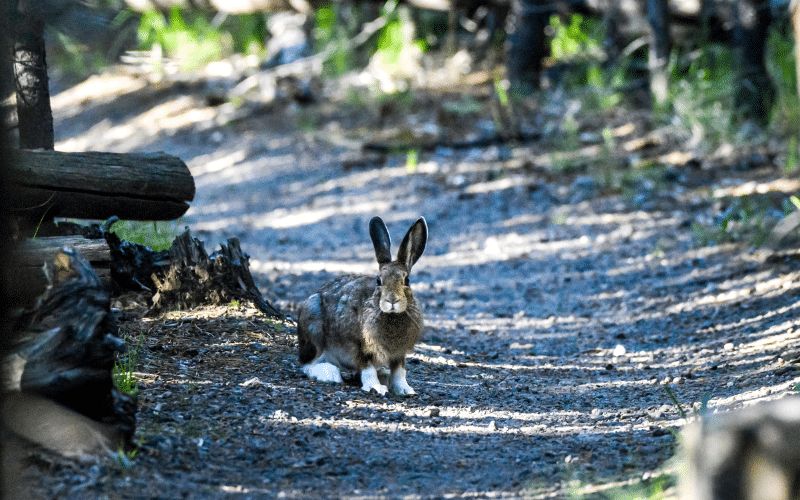
The vicinity of Blackwoods Campground became a favorite of ours for potential hare sightings. The dense cover of the surrounding forests offers them a sanctuary, a maze of escape routes from potential predators.
Snowshoe hares have an uncanny ability to change their coat color with the seasons. As winter approaches, their brown summer coat gives way to a pristine white one, offering them near invisibility against the snow.
Conversely, as snow melts and greenery returns, so does their brownish coloration.
If you traverse the serene, snow-laden paths of the Cadillac South Ridge Trail during winter or early spring, don’t be surprised to spot fresh tracks, a delicate imprint of a hare’s journey.
Amidst the white expanses, you might even be fortunate enough to observe their winter-white fur, a camouflage that shifts to a brownish hue as spring ushers in.
Raccoons
Curiosity often has a face in Acadia, and it’s masked, mischievous, and absolutely captivating – the face of the raccoon. These nocturnal rascals, with their iconic black masks and ringed tails, are known for their clever antics and adaptable nature.
While wandering the paths close to Jordan Pond, we often heard soft rustling or observed the tell-tale shimmer of their eyes reflecting our torchlights.
The gentle slopes and proximity to water sources in the area make it a favorite spot for raccoons, as they are never too far from their next aquatic snack.
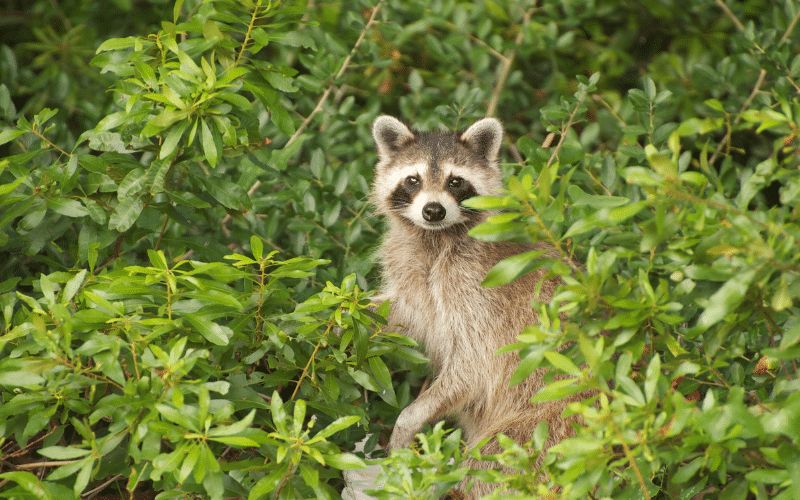
Seawall Campground, with its proximity to both forests and water, has been our raccoon rendezvous on more than one occasion.
Campers, beware! These intelligent creatures have mastered the art of scavenging, often managing to sneak into unsecured food containers or picnic baskets with an ease that’s almost admirable.
Raccoons have extremely sensitive hands, or ‘paws’, which they often use to ‘wash’ their food before eating.
This behavior isn’t really about cleanliness, but more about wetting their hands to heighten their sense of touch, allowing them to better feel their food and surroundings.
This tactile intelligence, combined with their adaptability, makes raccoons one of the most intriguing residents of Acadia.
Striped Skunks
The striped skunk, with its bold black and white pattern, is nature’s embodiment of charismatic confidence in Acadia.
Their unmistakable appearance is both a beauty to behold and a warning to those who might come too close, as anyone familiar with their pungent defense mechanism would attest!
During our explorations, the meadows surrounding Seawall Campground seemed to be particularly attractive to these creatures.
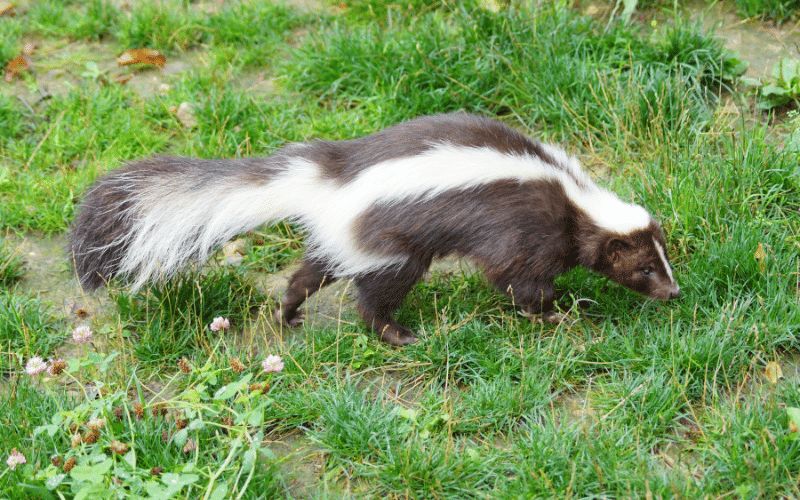
As dusk sets in, their characteristic waddle becomes a common sight as they set out in search of insects, small rodents, and fruits that form a significant part of their diet.
While hiking along the Ship Harbor Trail, we once stumbled upon a mother skunk, trailed by her litter of young kits. It was a gentle reminder of the nurturing side of nature, even amongst its more formidable members.
A curious fact about the striped skunk is its relatively docile demeanor. Despite its powerful defensive spray, which can deter predators from as far as ten feet away, skunks are generally peaceful creatures, preferring a quiet retreat over confrontation.
Their spray, produced by glands located near the base of the tail, is a last resort, used only when they feel severely threatened. This chemical concoction can temporarily blind and, undoubtedly, will leave a lasting memory on any overzealous intruder or curious camper.
Within the folds of Acadia’s landscape, the striped skunk stands as a symbol of nature’s balance between grace and grit, between allure and alarm.
Minks
In the nooks and crannies of Acadia’s wetlands and rocky coastlines, you might catch a fleeting glimpse of a lithe, dark-furred creature dashing between the rocks or swimming adeptly in search of prey.
This elusive creature, often mistaken for its relatives like the otter or weasel, is the mink.
The streams and ponds surrounding the Jordan Pond Path have often been a place where we’ve caught a brief sight of these agile carnivores.
With their semi-aquatic nature, minks prefer habitats that are close to water sources. They are known to feast on a range of aquatic delicacies from fish to crustaceans.
If you find yourself on the Precipice Trail, keep an eye out near the water sources. The mink’s keen senses and adaptability have made them proficient hunters, both on land and in water.
But don’t expect them to linger long in one place; their nimble nature ensures they’re often on the move.
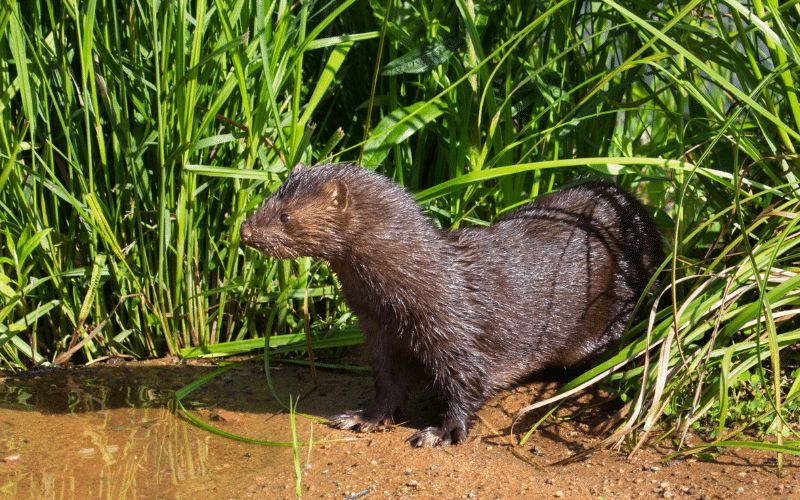
What’s fascinating about minks is their ability to adapt to both terrestrial and aquatic environments seamlessly.
Their sleek bodies are ideal for swimming, while their sharp claws allow them to grasp onto slippery prey with ease.
Minks might not be as conspicuous as some of Acadia’s larger mammals, but they represent the park’s hidden wonders, thriving quietly yet significantly in the intricate web of its ecosystems.
Their presence is a testament to the pristine conditions and the rich biodiversity that Acadia proudly hosts.
Coyotes
Coyotes, often dubbed the ‘songdogs’ of North America for their haunting and melodious howls, are not just inhabitants of the vast western plains.
They’ve established a stronghold in the east as well, with Acadia National Park serving as one of their treasured homes.
On one of our ventures near the Duck Harbor Campground, the distant, echoing call of a coyote welcomed the twilight.
These adaptive predators tend to roam the dense woodlands of the park, yet sometimes venture out to open meadows and fields, especially during the night.
If you’re hiking the Beehive Trail early in the morning or just as dusk approaches, remain attentive. The area is one where we’ve observed signs of coyote activity, from paw prints to droppings.
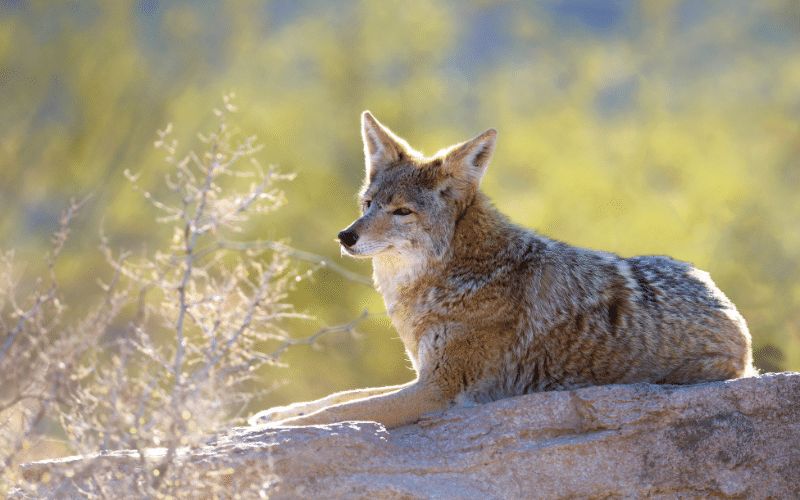
Their omnivorous diet means they can often be found hunting small mammals, but don’t be surprised to see them feasting on berries and fruits when available.
An intriguing aspect of the coyote’s behavior is their unparalleled adaptability. From the deserts of the Southwest to the snowy landscapes of the Northeast, coyotes have proven time and again their ability to thrive.
In Acadia, they’ve seamlessly integrated into the park’s diverse habitats, showcasing their prowess in both hunting and eluding larger predators.
Their presence in Acadia is a narrative of survival and adaptability. As the landscape of the park continues to evolve, the coyote stands as a symbol of nature’s resilience and ability to forge ahead amidst change.
Their occasional serenades, if you’re lucky enough to hear them, resonate as wild anthems of a land untamed.
Otters
Ah, the playful otters of Acadia! One of the park’s true delights is watching these nimble and animated creatures frolic in its freshwater lakes and streams.
Graceful in water and on land, otters are the embodiment of joy in the wild.
One of our most cherished memories in Acadia was while exploring the trails around Long Pond. As the morning mist began to lift, revealing the mirror-like water, a family of otters made their appearance.
With agile dives and exuberant play, they turned the serene environment into a scene of jubilant wilderness activity.
The Hadlock Ponds and the Bass Harbor Marsh are two other spots where you might get lucky to spot these aquatic mammals.
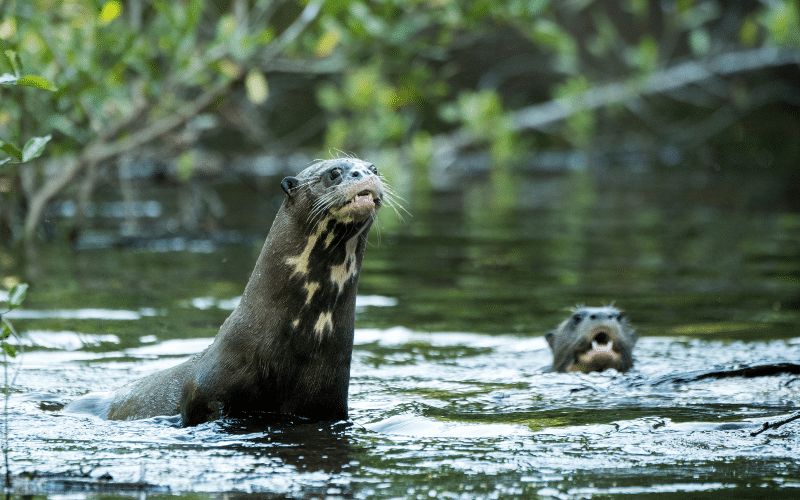
Otters are drawn to the rich, freshwater ecosystems that teem with their favorite meals – fish, amphibians, and crustaceans.
Apart from their playful nature, what’s remarkable about otters is their dexterity underwater.
Their streamlined bodies, webbed feet, and powerful tails make them exceptional swimmers, able to pursue and catch their prey with surprising speed.
Their dense fur, apart from being an insulator, is also incredibly buoyant, aiding them in their aquatic pursuits.
Witnessing otters in Acadia offers a brief but memorable peek into the vibrant aquatic life of the park.
As they slide, swim, and play, otters remind us of the sheer joy of existence and the unadulterated beauty of nature in motion.
Bobcats
There’s a secretive, elusive predator that roams the dense underbrush and rocky ledges of Acadia: the bobcat.
Unlike the playful otters or the frequently spotted white-tailed deer, seeing a bobcat is a rare treat, a moment of pure serendipity for any wildlife enthusiast.
On one particularly crisp morning, as we tread softly on the Gorham Mountain Trail, we chanced upon what can only be described as a fleeting shadow – the unmistakable tufted ears and short “bobbed” tail of a bobcat.
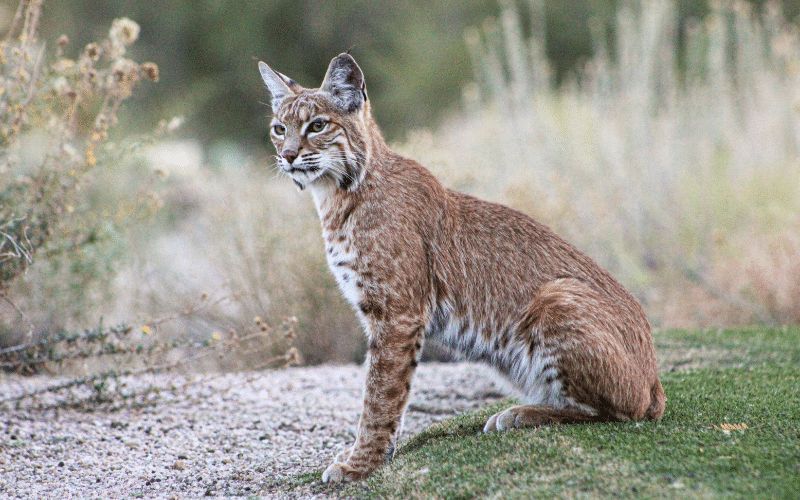
It was foraging near the trail, its spotted coat blending seamlessly with the dappled sunlight filtering through the trees.
Bobcats primarily inhabit the park’s more remote, rugged terrains, preferring the spaces where the forest meets rocky outcrops.
The Canon Brook Trail or parts of the Precipice Trail are some areas where you might detect signs of these feline hunters, from faint tracks to marks left on tree trunks.
What’s truly mesmerizing about bobcats is their innate hunting prowess.
Adept climbers and stealthy stalkers, they feed primarily on smaller mammals, from rabbits to rodents. Their sharp reflexes and keen eyesight make them formidable ambush predators.
But beyond their hunting abilities, bobcats hold a deeper significance in Acadia’s ecosystem.
Their presence is an indicator of a healthy, thriving environment. As apex predators, they play a crucial role in regulating prey populations and maintaining ecological balance.
Spotting a bobcat in Acadia might be a game of patience and luck, but even knowing they’re out there, silently treading the same trails and gazing at the same horizons, enriches the experience of every visitor to this splendid national park.
Black Bears
There’s a secretive, elusive predator that roams the dense underbrush and rocky ledges of Acadia: the bobcat.
Unlike the playful otters or the frequently spotted white-tailed deer, seeing a bobcat is a rare treat, a moment of pure serendipity for any wildlife enthusiast.
On one particularly crisp morning, as we tread softly on the Gorham Mountain Trail, we chanced upon what can only be described as a fleeting shadow – the unmistakable tufted ears and short “bobbed” tail of a bobcat.
A symbol of wilderness and an essential character in many a campfire tale, the black bear holds a special spot in the hearts of those who venture into Acadia’s forested realms.
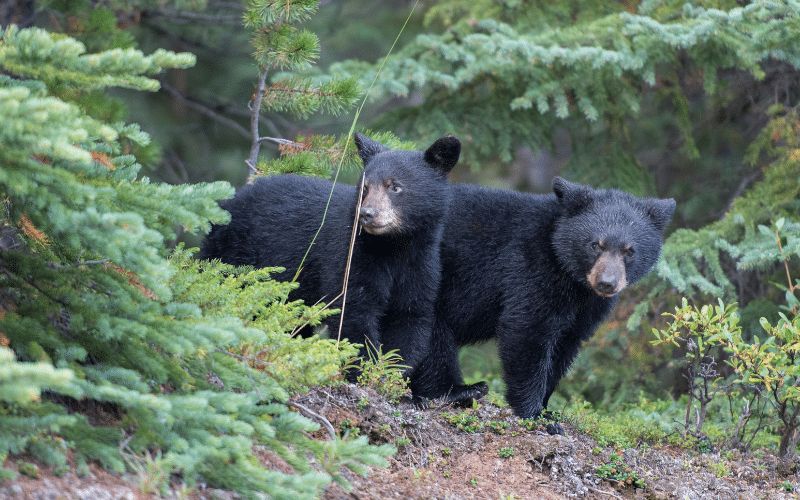
As one of the park’s largest mammals, they command respect and caution, but they also provide a thrilling glimpse into the raw beauty of nature.
It was on the edge of Bubble Pond, nestled amidst a setting sun, that we observed a mother bear and her cubs foraging along the shoreline.
Their thick, glossy coats were a testament to the park’s abundant resources and the safety of its territories.
While areas like the Jordan Pond Path or the trails around Cadillac Mountain might provide occasional sightings, bears, being the masters of stealth they are, prefer the park’s quieter corners.
The dense forests around Witch Hole Pond or the more secluded trails in the park’s west side offer them the solitude they desire.
Black bears have a varied diet, which includes berries, insects, and even fish. Their incredible sense of smell often leads them to food, but it’s essential for visitors to be bear-aware and not leave food unattended.
The adaptability of these bears, their ability to switch diets based on seasonality, and their knack for finding food make them incredible survivors.
Yet, their presence in Acadia is more than just about survival. It’s about coexistence.
Beavers
Beavers are found along the lower reaches of the tidal Schoodic River, and can often be seen on the banks of Jordan Pond.
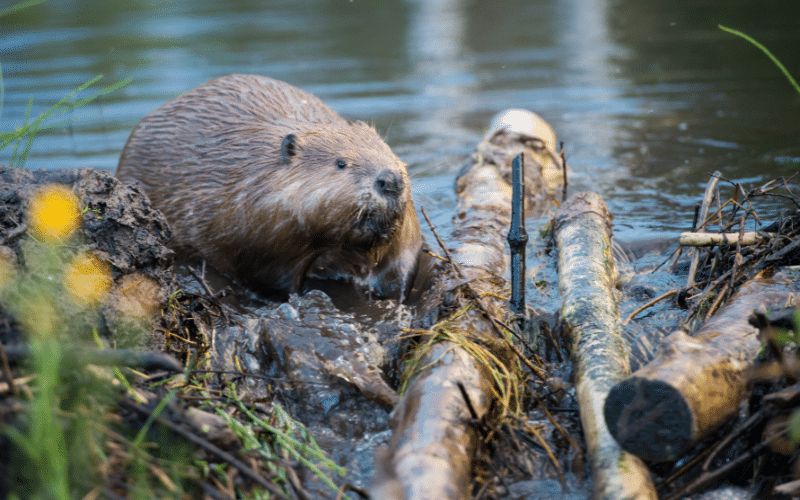
Acadia National Park is home to beavers, who build dams to create ponds and wetlands. The park’s beavers are found in the Blackwoods and Schoodic areas of the park.
Beavers are one of the largest rodents in North America. They are known for their distinctive tail, which is flat on top and paddle-shaped on the bottom.
Beavers have large front incisor teeth that grow continuously throughout their lives. They use these teeth to chew through trees and branches, creating dams and lodges that provide shelter from predators and cold temperatures.
The Spectacular Birds of Acadia
Acadia National Park, with its diverse habitats and unique location, is nothing short of a birdwatcher’s paradise.
As the seasons shift and the landscape transforms, the park becomes a stage for myriad avian wonders, from the tiniest songbirds to majestic raptors.
It’s not just the lush forests, serene ponds, or the rugged coastline that makes this park so inviting for birds, but the promise of sustenance, shelter, and a place to raise the next generation.
Bald Eagle
At the heart of Acadia’s bird population is the awe-inspiring Bald Eagle. A symbol of freedom and power, these raptors have made a remarkable comeback from the brink of extinction in the 20th century.
Today, their large nests, known as eyries, can be spotted atop tall pines or on craggy cliffs.
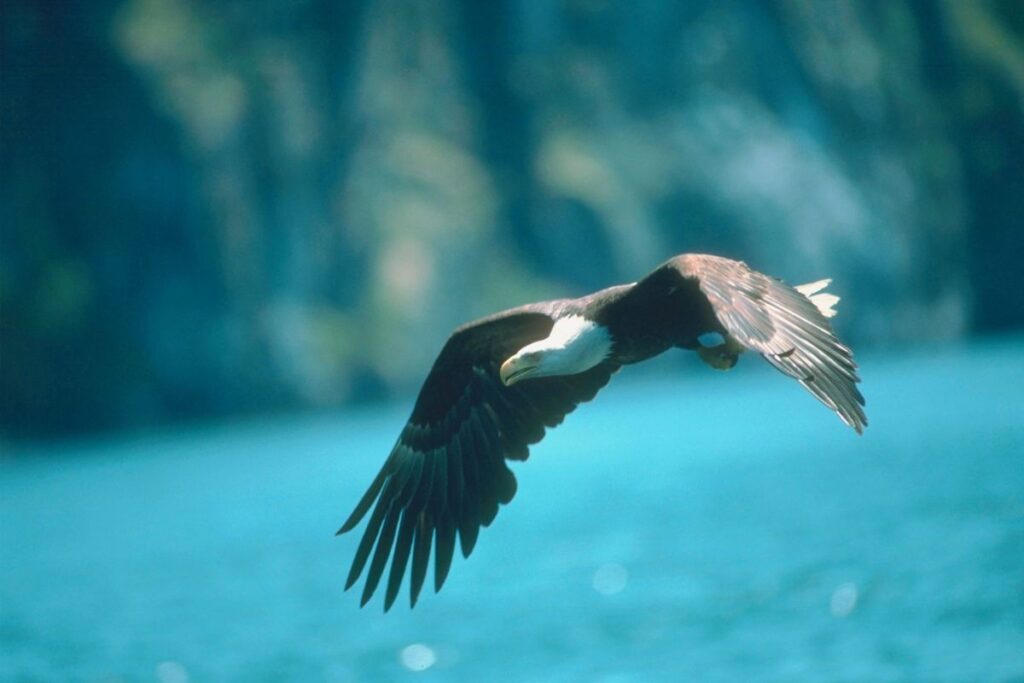
Eagle Lake, with its expansive freshwater body, serves as an excellent fishing ground for these birds.
The sight of a Bald Eagle soaring effortlessly, its white head and tail contrasting against the deep blue sky, is something that leaves visitors spellbound.
Their keen eyesight, powerful talons, and majestic wingspan make them one of the top predators of the skies.
Atlantic Puffin
But while the Bald Eagle might steal the limelight, there’s another bird that captures the hearts of many – the Atlantic Puffin.
Though not as commonly seen within the main areas of the park, these colorful seabirds, often dubbed the “clowns of the sea,” are an attraction around the nearby coastal islands.
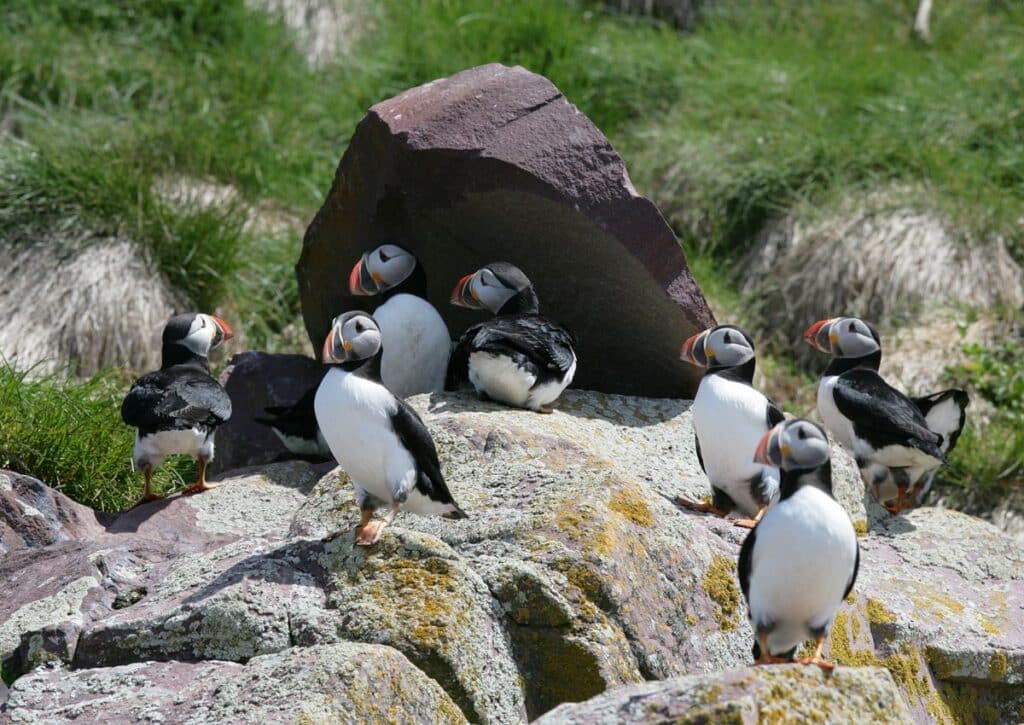
Their vividly-colored beaks, striking during the breeding season, and their comical mannerisms make them a joy to observe.
To catch a glimpse of puffins, one might need to venture on a boat trip off the coast, especially around the Isle au Haut region.
Watching these birds dive into the water, emerging with a beak full of fish, is a delightful spectacle.
Peregrine Falcon
The Peregrine Falcon is not just a bird; it’s a marvel of evolution.
Renowned as the fastest bird in the world, it can reach speeds up to 240 mph during its hunting stoop (high-speed dive).
Acadia National Park serves as one of the vital recovery sites for this once-endangered raptor.
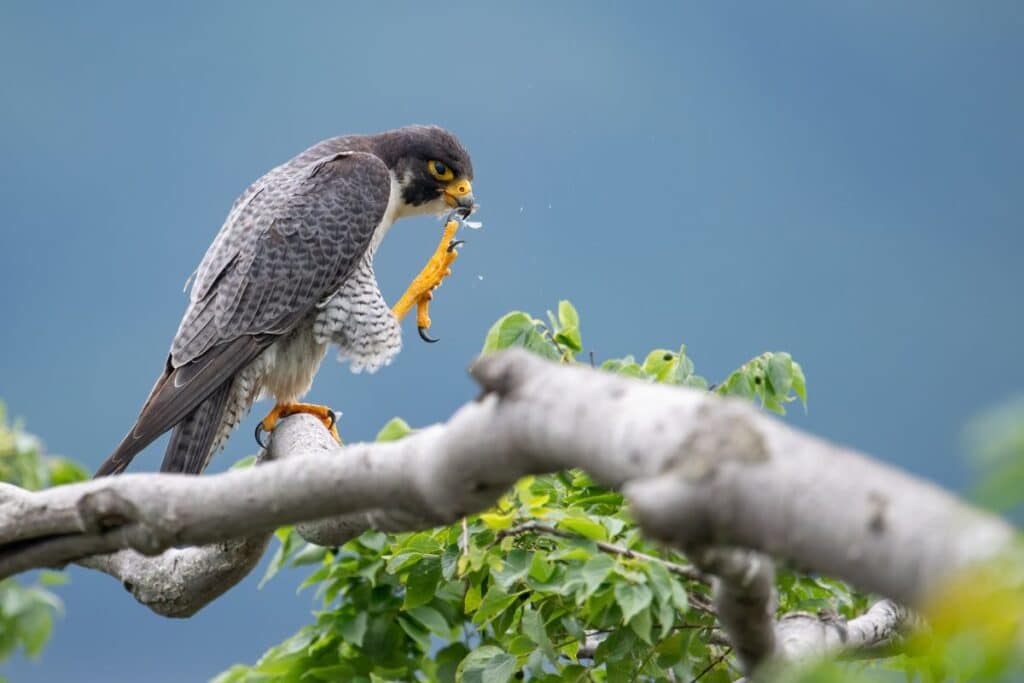
The precipitous cliffs of Precipice Trail and Jordan Cliffs, where hiking is seasonally restricted to protect nesting falcons, provide an ideal nesting environment.
The agile falcons can be seen performing aerial acrobatics as they chase prey or ward off intruders.
Their slate-blue wings, sharp beak, and intense eyes make them a formidable predator.
Their return from the brink of extinction in the U.S., thanks to extensive conservation efforts, stands as a testament to human perseverance and nature’s resilience.
Common Loon
The haunting, eerie calls of the Common Loon echo across Acadia’s freshwater lakes, particularly Jordan Pond and Eagle Lake.
With striking black and white plumage and ruby-red eyes, these birds are a symbol of wilderness and untouched beauty.
Loons are exceptional divers, often submerging for up to a minute as they hunt for fish in the clear waters.
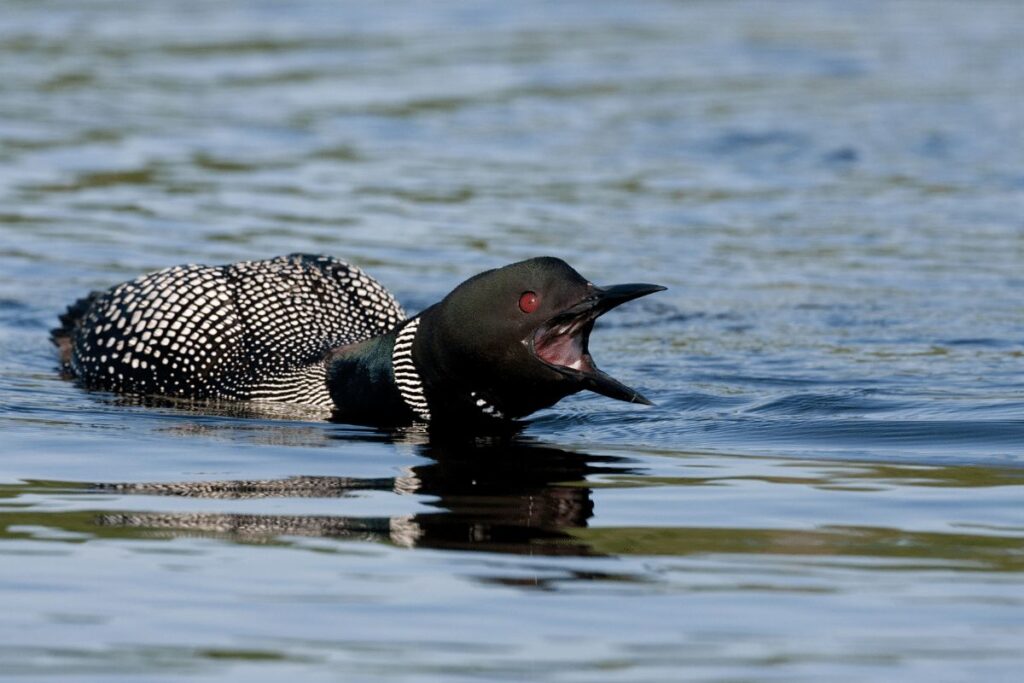
They’re also known for their migratory patterns, with many traveling significant distances during different seasons.
Watching a loon glide serenely across the water during a misty morning in Acadia is a memory many visitors cherish, embodying the peace and tranquility the park offers.
Osprey
Often confused with the Bald Eagle due to its size and presence around water, the Osprey has its own set of admirers.
Known as ‘fish hawks’, these birds have specialized hunting techniques, diving feet first to grasp fish with their sharp talons.
Their nests, made up of sticks and often reused year after year, can be seen atop dead trees or even man-made platforms.
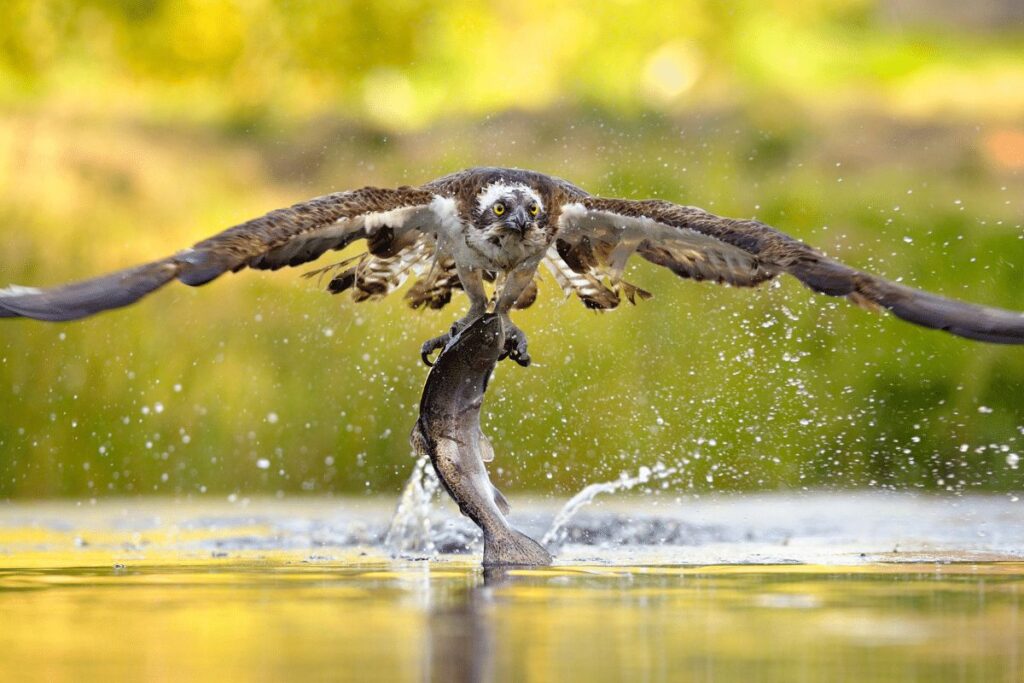
The coastal regions of Acadia, with an abundance of fish, provide a rich hunting ground for these skilled fishers.
The sight of an Osprey, wings outstretched, clutching a fish in its talons and heading back to its nest, is one of the signature sights of coastal Maine and a testament to the rich biodiversity of Acadia.
These birds, along with many others, paint the skies of Acadia with colors, calls, and an unmatched vitality, making every birdwatching trip an adventure of discovery.
An Overview of Acadia National Park’s Diversity
What’s the secret behind Acadia’s bustling wildlife? Diversity.
The park is home to an array of habitats, each catering to different sets of species. Take a walk through its deep, verdant forests, and you might encounter a playful snowshoe hare or a white-tailed deer cautiously nibbling on foliage.
Move on to its pristine freshwater lakes, and you could spot otters playfully gliding through the water.
Venture a bit further, where the forest meets the sea, and the salty aroma of the Atlantic greets you, with tidal zones that might just reveal a lurking mink or a foraging raccoon.
Then there are the wetlands, often hidden and less trodden, where the symphony of amphibians and the sight of barred owls add layers of life and sound.
But these habitats don’t just exist in isolation. They’re shaped, nurtured, and sometimes challenged by Acadia’s unique climate and geographical setting.
The park, due to its position, experiences a blend of maritime and continental climates. These cold winters often see animals like the red fox adapting, donning thick fur coats, while warm summers are a paradise for species like the striped skunks to forage and thrive.
This dance of the seasons ensures that wildlife has intricately adapted over generations, making the most of the climatic rhythms.
Acadia’s varied terrain further accentuates its biodiversity. Rising from the ocean, its mountains, especially the iconic Cadillac Mountain, house different ecological zones.
As you ascend, the flora and fauna transition: at lower altitudes, raccoons and minks, and as you climb higher, perhaps a rare sighting of a bobcat, standing testament to nature’s beautiful adaptability.
The park’s geography and climate aren’t mere backdrops; they’re the driving forces behind this wildlife theater.
When you next tread on Acadia’s paths, remember: every trail, every viewpoint is more than just a treat for the eyes. It’s a passage into a vibrant world of wildlife, an intricate mosaic shaped by the park’s habitats, climate, and geography.
Hiking Trails in Acadia: Our Paths to Wildlife Encounters
One of the best ways to truly immerse yourself in the wild tapestry of Acadia National Park is by taking to its trails. While many parks offer a driving experience or a single viewpoint, Acadia demands exploration on foot.
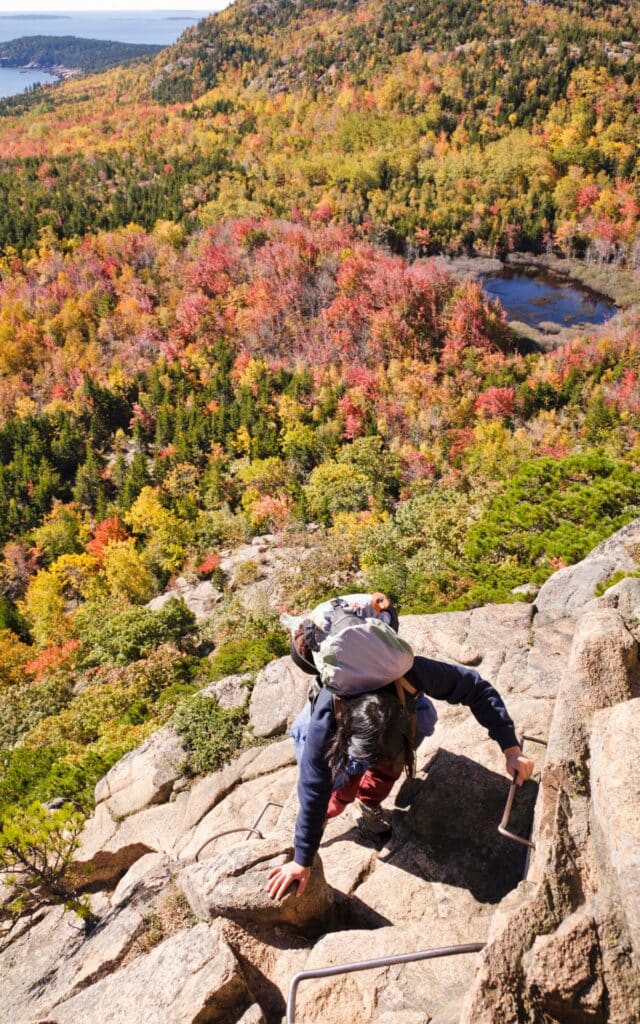
For us, every step brought a new revelation, a fresh perspective, and often, a chance to glimpse the park’s resident animals in their natural habitats.
Jordan Pond Path: Our adventure began with the Jordan Pond Path, a trail renowned not just for its breathtaking views of the twin mountains – the Bubbles – but also for the chance to spot the Common Loon.
The pristine waters reflecting the azure sky, punctuated by the calls of loons, made for a serene experience.
Precipice Trail: A challenging ascent, but worth every ounce of effort. The sheer cliffs here are home to the Peregrine Falcon, and the trail offers an unparalleled vantage point to observe these magnificent birds in flight.
It’s also a testament to the resilience of nature, as these falcons once faced extinction.
Ship Harbor Trail: A beautiful coastal trail where we found tidal pools brimming with marine life. More than once, playful otters were seen diving in and out of the water, their sleek bodies effortlessly gliding.
It’s not the most strenuous of hikes, but certainly one rich in natural rewards.
Cadillac Mountain’s South Ridge Trail: An iconic trail for those hiking in Acadia. The panoramic views from the summit are breathtaking, but along the ascent, it’s possible to encounter a multitude of creatures.
From the ever-watchful minks to the occasional deer, nature’s surprises are aplenty here.
Jordan Cliffs: Another great spot for Peregrine Falcon sightings. The trail runs along the cliffs, offering not only an adrenaline-pumping hiking experience but also panoramic views that make one feel on top of the world.
On one fortunate day, an osprey graced our hike, its wings cutting the sky with grace.
Also Read: ACADIA NATIONAL PARK: 9 OF OUR FAVORITE HIKING TRAILS IN FALL
The diversity of these trails, each weaving through unique ecosystems, ensures varied encounters with the park’s wildlife. From the depths of freshwater ponds to the heights of towering cliffs, Acadia’s trails bridge the gap between us and the wild wonders of this national park.
10 FAQs About Animals in Acadia National Park
Acadia National Park is home to some of the most beautiful and unique wildlife species in the United States. If you’re planning a trip to this stunning park, it’s important to know what animals you might expect to see while you’re there. Here we answer 10 of the most common questions about Acadia National Park’s wildlife – so that your trip can be as safe and enjoyable as possible!
Are There Moose In Acadia?
There are moose in Acadia National Park! They are however very rare and hard to find while camping or hiking there. Ranger Dusty Warner, one of Acadia’s veteran rangers, has only seen 3 live moose in the 20 years he has worked here. These moose were all transients; in other words, they had wandered over and did not stay on the islands for very long.
Are there Bears in Acadia National Park?
Did you know that some of the visitors to Acadia National Park really like to ask about black bears? They’re pretty cool animals, but the chances of actually seeing one in the park are only a little bit better than seeing a moose. However, unlike moose, there is a small group of black bears that live on the island permanently.
Even though they’re not always easy to spot, there are scattered reports every year of black bears roaming around on Mount Desert Island. These bears are really interesting creatures – they can climb trees and swim, and they have a great sense of smell that helps them find food in the wild.
If you’re lucky enough to spot a black bear in Acadia, it’s important to remember to keep your distance and not approach them. Just enjoy watching them from a safe distance and take some pictures to remember your encounter with one of the coolest animals in the park!
We did see one for a good 15 mins!
Are There Grizzly Bears In Acadia?
There are no grizzly bears in Acadia, or in the whole state of Maine. Grizzly bears used to live in a big area from Canada to Mexico, but people moved west and it made it harder for them to live there. Now, there are only a few states in the west and Canada where they can still be found. Maine is too far east for grizzly bears, so they’ve never lived there
Are There Snakes In Acadia?
Snakes are not commonly seen in Acadia National Park, but they do exist. The two species of snakes that are most often seen in the park are the garter snake and the milk snake. Both of these snakes are harmless to humans and are actually beneficial, as they help to control populations of rodents and other small animals.
If you do see a snake while hiking or camping in Acadia, it is best to leave it alone and give it space.
Other snakes found in Acadia are the smooth green snake, redbelly snake, ringneck snake and eastern milksnake.
Are There Otters In Acadia?
Otters are not commonly seen in Acadia National Park, but they have been known to inhabit the park on occasion. If you’re hoping to spot an otter during your visit, your best bet is to look for them near bodies of water such as lakes or streams. Keep your eyes peeled for these playful creatures frolicking in the water or basking on the shore! We did see a few though!!
Are There Mountain Lions In Acadia?
Did you know that Acadia National Park used to be home to some really amazing animals, like gray wolves and mountain lions? These animals are also known as predators because they hunt other animals for food.
Gray wolves are very big and have gray fur. They are also known as timber wolves or western wolves. They used to live in the forests and grasslands of North America, including Acadia National Park. However, people hunted them a lot in the past, and their population decreased. As a result, they are no longer found in Acadia National Park, or in most of the eastern United States.
Mountain lions, also known as cougars or pumas, used to roam the forests of North America too. They are very big and have golden-brown fur. Mountain lions are very good at hunting and are able to climb trees and swim to catch their prey.
Like gray wolves, people hunted them a lot and their population decreased. Now, they are also not found in Acadia National Park or in most of the eastern United States.
Although gray wolves and mountain lions are no longer found in Acadia National Park, the park is still home to many other amazing animals like moose, black bears, and bald eagles.
Are There Dolphins In Acadia?
Dolphins are not commonly seen in Acadia National Park, but they have been known to swim in the waters off the coast of Maine. If you’re hoping to see a dolphin during your visit to Acadia, keep your eyes peeled for any signs of them in the water. Also, be sure to ask Rangers and other park staff if they have any recent reports of dolphin sightings.
Can you see whales from Acadia National Park?
Yes, you can see whales from Acadia National Park! In fact, whale watching is one of the most popular activities in the park. There are several different species of whales that can be seen in the waters off Acadia, including humpback whales, fin whales, and minke whales. The best time of year for whale watching is typically from June to October.
Are There Bald Eagles In Acadia?
There are indeed bald eagles in Acadia National Park! These magnificent birds can often be seen soaring over the lakes and rivers of the park, or perched atop a tree. While they are most active in the early morning or late afternoon, they can sometimes be seen hunting or fishing during the day. If you’re lucky enough to spot one of these majestic creatures, be sure to take a moment to enjoy the experience.
Are there Puffins in Acadia National Park?
Yes, you see puffins in Acadia. The Maine ocean islands provide the only nesting sites for Atlantic puffins in the United States. Eastern Egg Rock in the midcoast region, Seal Island and Matinicus Rock at the mouth of Penobscot Bay, and Machias Seal Island and Petit Manan Island off the downeast coast provide habitat for more than 4,000 puffins each summer.
Conclusion
Acadia National Park is greatly endeared to millions of land lovers and nature enthusiasts. The same appeal can be multiplied with the addition of stunningly beautiful Acadia National Park animals that are frequently spotted by hikers, campers and visitors.
The fauna of Acadia is diverse, and all the animals listed above are found in this national park. Acadia is a beautiful place to visit if you’re an animal lover, so if you get the chance we highly recommend it.

